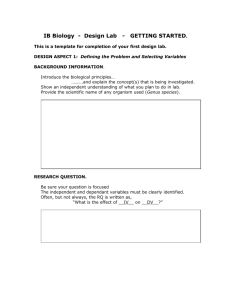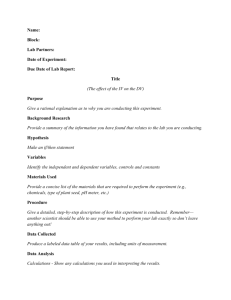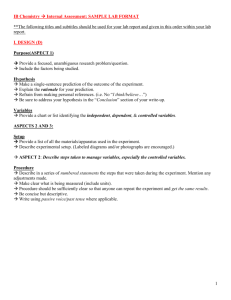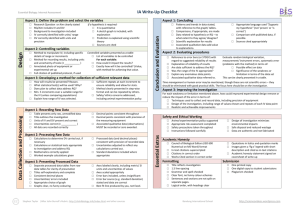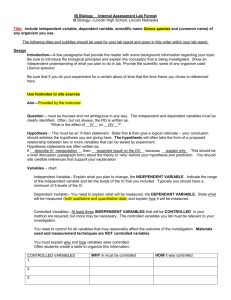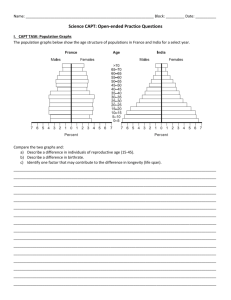IB Biology Lab Report Writing Guide
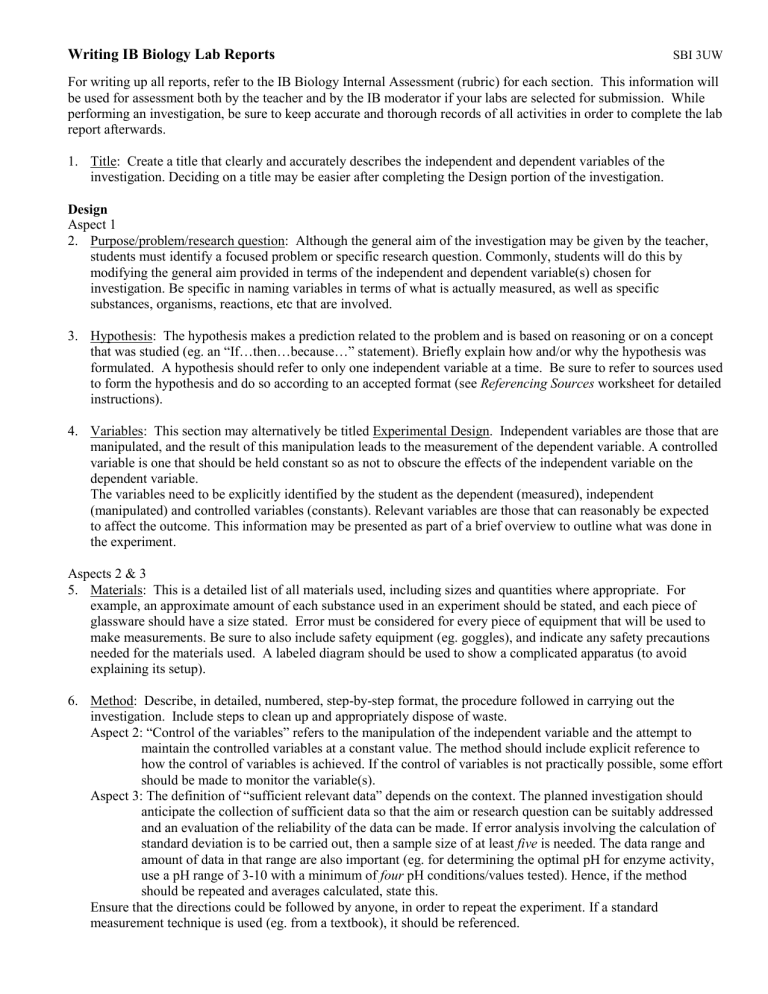
Writing IB Biology Lab Reports
SBI 3UW
For writing up all reports, refer to the IB Biology Internal Assessment (rubric) for each section. This information will be used for assessment both by the teacher and by the IB moderator if your labs are selected for submission. While performing an investigation, be sure to keep accurate and thorough records of all activities in order to complete the lab report afterwards.
1.
Title: Create a title that clearly and accurately describes the independent and dependent variables of the investigation. Deciding on a title may be easier after completing the Design portion of the investigation.
Design
Aspect 1
2.
Purpose/problem/research question: Although the general aim of the investigation may be given by the teacher, students must identify a focused problem or specific research question. Commonly, students will do this by modifying the general aim provided in terms of the independent and dependent variable(s) chosen for investigation. Be specific in naming variables in terms of what is actually measured, as well as specific substances, organisms, reactions, etc that are involved.
3.
Hypothesis: The hypothesis makes a prediction related to the problem and is based on reasoning or on a concept that was studied (eg. an “If…then…because…” statement). Briefly explain how and/or why the hypothesis was formulated. A hypothesis should refer to only one independent variable at a time. Be sure to refer to sources used to form the hypothesis and do so according to an accepted format (see Referencing Sources worksheet for detailed instructions).
4.
Variables: This section may alternatively be titled Experimental Design. Independent variables are those that are manipulated, and the result of this manipulation leads to the measurement of the dependent variable. A controlled variable is one that should be held constant so as not to obscure the effects of the independent variable on the dependent variable.
The variables need to be explicitly identified by the student as the dependent (measured), independent
(manipulated) and controlled variables (constants). Relevant variables are those that can reasonably be expected to affect the outcome. This information may be presented as part of a brief overview to outline what was done in the experiment.
Aspects 2 & 3
5.
Materials: This is a detailed list of all materials used, including sizes and quantities where appropriate. For example, an approximate amount of each substance used in an experiment should be stated, and each piece of glassware should have a size stated. Error must be considered for every piece of equipment that will be used to make measurements. Be sure to also include safety equipment (eg. goggles), and indicate any safety precautions needed for the materials used. A labeled diagram should be used to show a complicated apparatus (to avoid explaining its setup).
6.
Method: Describe, in detailed, numbered, step-by-step format, the procedure followed in carrying out the investigation. Include steps to clean up and appropriately dispose of waste.
Aspect 2: “Control of the variables” refers to the manipulation of the independent variable and the attempt to maintain the controlled variables at a constant value. The method should include explicit reference to how the control of variables is achieved. If the control of variables is not practically possible, some effort should be made to monitor the variable(s).
Aspect 3: The definition of “sufficient relevant data” depends on the context. The planned investigation should anticipate the collection of sufficient data so that the aim or research question can be suitably addressed and an evaluation of the reliability of the data can be made. If error analysis involving the calculation of standard deviation is to be carried out, then a sample size of at least five is needed. The data range and amount of data in that range are also important (eg. for determining the optimal pH for enzyme activity, use a pH range of 3-10 with a minimum of four pH conditions/values tested). Hence, if the method should be repeated and averages calculated, state this.
Ensure that the directions could be followed by anyone, in order to repeat the experiment. If a standard measurement technique is used (eg. from a textbook), it should be referenced.
Data Collection and Processing
Aspect 1
7.
Observations: Raw data must be recorded. Raw data is the actual data measured, and may include associated qualitative data. The term “quantitative data” refers to numerical measurements of the variables associated with the investigation. Associated qualitative data are considered to be those observations that would enhance the interpretation of results. Present the data in a form that is easily understood, such as using titled tables (see 5 below for more information about titles and numbering) to organize the data. Uncertainties are associated with all raw data and an attempt should always be made to quantify uncertainties. Within tables of quantitative data, columns should be clearly annotated with a heading, units and an indication of the uncertainty of measurement.
Uncertainties are recorded as
(+/-). The number of significant digits should reflect the precision of the measurement. Ensure also to record only results obtained; no manipulated data should appear in this section.
Aspects 2
8.
Analysis: Data processing involves, for example, combining and manipulating raw data to determine the value of a physical quantity (such as adding, subtracting, squaring, dividing), and taking the average of several measurements and transforming data into a form suitable for graphical representation. One sample calculation for each type of calculation must be shown, including the general formula(s). The rest of the calculated values should be presented in a table. The recording and processing of data may be shown in one table provided they are clearly distinguishable. For data derived from processing raw data (eg. means), the level of precision (ie. significant digits) should be consistent with that of the raw data.
Aspect 3
Students are expected to decide upon a suitable presentation format themselves (for example, spreadsheet, table, graph, chart, flow diagram, and so on). There should be clear, unambiguous headings/titles for calculations, tables or graphs. Graphs and illustrations are figures (for example, Fig. 1); tables are tables (for example, Table 1).
Tables and figures must be numbered consecutively through the report. Graphs need to have appropriate scales, labeled axes with units, and accurately plotted data points with a suitable best-fit line or curve (not a scattergraph with data-point to data-point connecting lines). Students should present the data so that all the stages to the final result can be followed. Inclusion of metric/SI units is expected for final derived quantities, which should be expressed to the correct number of significant figures. The uncertainties associated with the raw data must be taken into account. The treatment of uncertainties in graphical analysis requires the construction of appropriate best-fit lines. Error bars on data points are a perfectly acceptable way of expressing the degree of uncertainty in the data. The treatment of uncertainties should be in accordance with assessment statements 1.1.2, 1.1.3 and 1.1.4 of Topic 1: Statistical Analysis. Statements about patterns or trends may be made here.
Conclusion & Evaluation
Aspect 1
9.
Conclusion: Give a valid conclusion, based on the correct interpretation of the results. Analysis may include comparisons of different graphs or descriptions of trends shown in graphs. An explanation must be included and should contain observations, trends or patterns revealed by the data. When measuring an already known and accepted value of a physical quantity, students should draw a conclusion as to their confidence in their result by comparing the experimental value with the textbook or literature value. The literature consulted should be fully referenced.
Aspect 2
10.
Evaluation: The design and method of the investigation must be commented upon as well as the quality of the data. The student must not only list the weaknesses but must also appreciate how significant the weaknesses are
(ie. their effect on the dependent variable). Comments about the precision and accuracy of the measurements are relevant here. When evaluating the procedure used, the student should specifically look at the processes, and use of equipment. Sometimes little can be concluded from an investigation—this situation gives great opportunity to evaluate the investigation and how it could be improved.
Aspect 3
Suggestions for improvements should be based on the weaknesses and limitations identified in aspect 2.
Modifications to the experimental techniques and the data range can be addressed here. The modifications proposed should be realistic and clearly specified. It is not sufficient to state generally that more precise equipment should be used.


